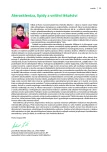Early diagnosis of familial hypercholesterolemia in Czech Republic in pursuance of MedPed Project
Authors:
Tomáš Freiberger 1; Michal Vrablík 2
Authors‘ workplace:
Genetická laboratoř, Centrum kardiovaskulární a transplantační chirurgie, Brno, ředitel doc. MUDr. Petr Němec, CSc., MBA, FETCS
1; III. interní klinika1. LF UK a VFN Praha, přednosta prof. MUDr. Štěpán Svačina, DrSc., MBA
2
Published in:
Vnitř Lék 2015; 61(11): 942-945
Category:
Reviews
Overview
Recent studies have revealed the prevalence of familial hypercholesterolemia (FH) is approximately twice higher than previously estimated and, thus, the disease affects one in 250 persons from the general population. Therefore FH remains the most frequent inherited metabolic disorder. Due to the genetic defect LDL-cholesterol accumulates both in the plasma and tissues leading to premature and accelerated atherosclerosis. Untreated patients with FH might suffer from myocardial infarction in the third or fourth decade, one third of these events being fatal. The disease is underdiagnosed and undertreated worldwide. In the Czech Republic the MedPed project focused on early diagnosis and initiation of proper treatment of FH aiming at lowering of the above mentioned risks was initiated in 1998. A crucial part of the project is so called cascade screening among the relatives of identified FH probands. There are 6,350 registered FH subjects in the nationwide registry, which represents 16% of the expected number of FH patients in the Czech Republic. This result of screening efforts ranks among the top countries in the world, however, also in spite of the recent expansion of FH treatment options early detection and initiation of treatment of FH remains in the centre of our attention.
Key words:
familial hypercholesterolemia – cardiovascular risk – cascade screening – MedPed
Sources
1. Goldstein, JL, Hobbs, HH, Brown, MS. Familial hypercholesterolemia. In: Scriver CR et al. The metabolic and molecular bases of inherited disease. 8th ed. New York, McGraw-Hill 2001 : 2863–2914.
2. Baigent C, Blackwell L, Emberson J et al. Efficacy and safety of more intensive lowering of LDL cholesterol: a meta-analysis of data from 170,000 participants in 26 randomised trials. Lancet 2010; 376(9753): 1670–81.
3. Marks D, Thorogood M, Neil SM et al. A review on the diagnosis, natural history, and treatment of familial hypercholesterolaemia. Atherosclerosis 2003; 168(1): 1–14.
4. Benn M, Watts GF, Tybjaerg-Hansen A et al. Familial hypercholesterolemia in the danish general population: prevalence, coronary artery disease, and cholesterol-lowering medication. J Clin Endocrinol Metab 2012; 97(11): 3956–3964.
5. Sjouke B, Kusters DM, Kindt I et al. Homozygous autosomal dominant hypercholesterolaemia in the Netherlands: prevalence, genotype-phenotype relationship, and clinical outcome. Eur Heart J 2015; 36(9): 560–565.
6. Goldstein JL, Brown MS. Familial hypercholesterolemia: identification of a defect in the regulation of 3-hydroxy-3-methylglutaryl coenzyme A reductase activity associated with overproduction of cholesterol. Proc Natl Acad Sci USA 1973; 70(10):2804–2808.
7. Nordestgaard BG, Chapman MJ, Humphries SE et al. For the European Atherosclerosis Society Consensus Panel. Familial hypercholesterolaemia is underdiagnosed and undertreated in the general population: guidance for clinicians to prevent coronary heart disease: Consensus Statement of the European Atherosclerosis Society. Eur Heart J 2013; 34(45): 3478–3490a.
8. Descamps OS, Tenoutasse S, Stephenne X et al. Management of familial hypercholesterolemia in children and young adults: consensus paper developed by a panel of lipidologists, cardiologists, paediatricians, nutritionists, gastroenterologists, general practitioners and a patient organization. Atherosclerosis 2011; 218(2): 272–280.
9. Vrablík M, Češka R, Freiberger T et al. Souhrn konsenzu panelu expertů European Atherosclerosis Society k otázce diagnostiky a klinickému vedení nemocných s homozygotní formou familiární hypercholesterolemie. Hypertenze a KV prevence 2015, 4 : 59–61.
10. Williams RR, Hunt SC, Schumacher MC et al. Diagnosing heterozygous familial hypercholesterolemia using new practical criteria validated by molecular genetics. Am J Cardiol 1993, 72(2): 171–176.
11. van Aalst-Cohen ES, Jansen AC, Tanck MW, Defesche JC, Trip MD, Lansberg PJ et al. Diagnosing familial hypercholesterolaemia: the relevance of genetic testing. Eur Heart J 2006; 27(18): 2240–2246.
12. Varret M, Abifadel M, Rabès JP et al. Genetic heterogeneity of autosomal dominant hypercholesterolemia. Clin Genet 2008; 73(1): 1–13.
13. Rader DJ, Cohen J, Hobbs HH. Monogenic hypercholesterolemia: new insights in pathogenesis and treatment. J Clin Invest 2003; 111(12): 1795–803.
14. World Health Organization: Familial hypercholesterolemia – report of a second WHO Consultation. Geneva, Switzerland: World Health Organization 1999 (WHO publication No. WHO/HGN/FH/CONS/99.2). Dostupné z WWW: <http://apps.who.int/iris/bitstream/10665/66346/1/WHO_HGN_FH_CONS_99.2.pdf>.
15. Freiberger T, Vrablík M. 15 let projektu MedPed v České republice. Hypertenze a KV prevence 2013, 2 : 58–60.
Labels
Diabetology Endocrinology Internal medicineArticle was published in
Internal Medicine

2015 Issue 11
Most read in this issue
- Clinical importance of basal insulin analogues and insulin Toujeo® 300 units/ml
- Atherosclerosis: from etiology to its possible influencing
- Position of lipoprotein apheresis in present
- Practical approach to statin intolerance
